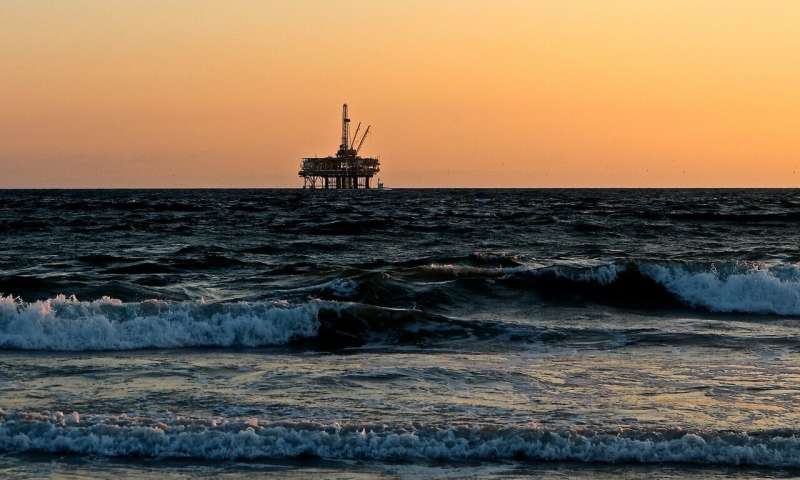As oil and dead wildlife wash up, California seeks end to offshore drilling. Why its hands are tied

As dead birds wash ashore on Southern California beaches, the victims of a major oil spill, environmentalists are calling on Gov. Gavin Newsom to reduce the state's ties to the oil industry.
But the oil spill fouling Orange County's shoreline occurred outside the state's jurisdiction.
Once the oil industry moves more than three miles offshore, into waters controlled by the federal government, California's power shrinks considerably—a point that's been driven home dramatically by the massive oil spill that occurred over the weekend south of Long Beach.
The spill has dumped gooey oil deposits on the Orange County coastline, as witnesses reported dead birds and fish washing up on Huntington Beach. An estimated 120,000 gallons of oil have leaked out.
The tragedy began Saturday with a leak in a pipeline connected to an oil platform called Elly that sits in federal waters about 17 miles off the California coast. Executives of Houston-based Amplify Energy, parent of the platform operator, said the leak probably developed about four miles offshore, according to the Los Angeles Times. The pipeline connects the platform to a pump station in Long Beach.
"This is a platform in federal waters, licensed by the federal government," said Sean Hecht, a UCLA environmental law expert. "The existence of these federally permitted platforms lowers the ability of the state to address this."
That hasn't stopped some environmental groups from urging Newsom to act. At the very least, says Laura Deehan of the group Environment California, the state can do more to lessen its demand for oil and gas.
Offshore oil drilling exists in order to meet "our current demand and dependence on oil and gas," she said.
The state has moved to shrink the industry's footprint. After the historic Santa Barbara oil spill of 1969, which helped trigger the modern environmental movement, the state hasn't approved a single lease for offshore oil and natural gas production within its territorial waters. However, the state has permitted new drilling on existing leases, to the dismay of environmentalists.
The latest spill comes two weeks after the Los Angeles County Board of Supervisors banned new oil drilling in unincorporated areas of the county. The board also initiated the process of phasing out existing production.
But the county's authority doesn't extend into the ocean waters.
Some California Democratic members of Congress are trying to put an end to new offshore drilling. After President Joe Biden imposed a temporary moratorium on new offshore permits, Sen. Dianne Feinstein and Rep. Jared Huffman introduced bills to make the ban permanent on the West Coast. The legislation has been rolled into the budget reconciliation bill that's struggling to get through Congress.
"When you drill you spill, and once again the inevitable has happened," Huffman tweeted, arguing that the legislation must pass. Feinstein and U.S. Sen. Alex Padilla, a co-sponsor of the bill, also issued statements saying the oil spill is further evidence of the urgency of their legislation.
The spill illustrates a dual personality in California's economic landscape: A state trying to wean itself from fossil fuels relies on oil production for thousands of jobs.
California produced 156.4 million barrels of oil in 2019, the last year for which statistics were available, according to the state Department of Conservation. About 7 million of those barrels were produced offshore. Although the industry has shrunk dramatically in recent years—production peaked at 400 million barrels in the mid-1980s—California is still the nation's seventh-largest oil producer. The capital of the state's oil industry is in Kern County.
The industry has had relatively little to say about the spill. The Western States Petroleum Association, the industry's major lobbying group in Sacramento, issued a statement saying, "Every spill is a tragedy," but adding that the Elly isn't operated by a WSPA member.
How California thwarted Trump's offshore plan
When former President Donald Trump proposed a substantial expansion of offshore drilling in federal waters, California quickly responded with legislation that essentially curtained off the state from any new offshore oil.
In September 2018, just months after Trump unveiled his plan, former Gov. Jerry Brown signed two bills, AB 1775 and SB 834, that thwarted the White House. The bills prohibited the construction of pipelines or other infrastructure to bring that oil from new offshore facilities onto state land. Several other states passed similar legislation.
"It's not like the state doesn't have any power," Hecht said.
California is doing what it can to kill its oil-production industry.
In April, Newsom issued an executive order saying the state will stop issuing new permits for hydraulic fracturing, also known as fracking, by 2024. In that same order, he directed the California Air Resources Board to "analyze pathways" to shutter all of the state's oil wells by 2045. That's also the deadline set by the Legislature for eliminating fossil fuel generation from the electric grid.
Environmentalists, though, say the state should move away from oil even sooner.
"California's timeline is clearly too slow," said Deehan of Environment California. "The state really needs to lead the way and accelerate the transition."
©2021 The Sacramento Bee. Distributed by Tribune Content Agency, LLC.




















